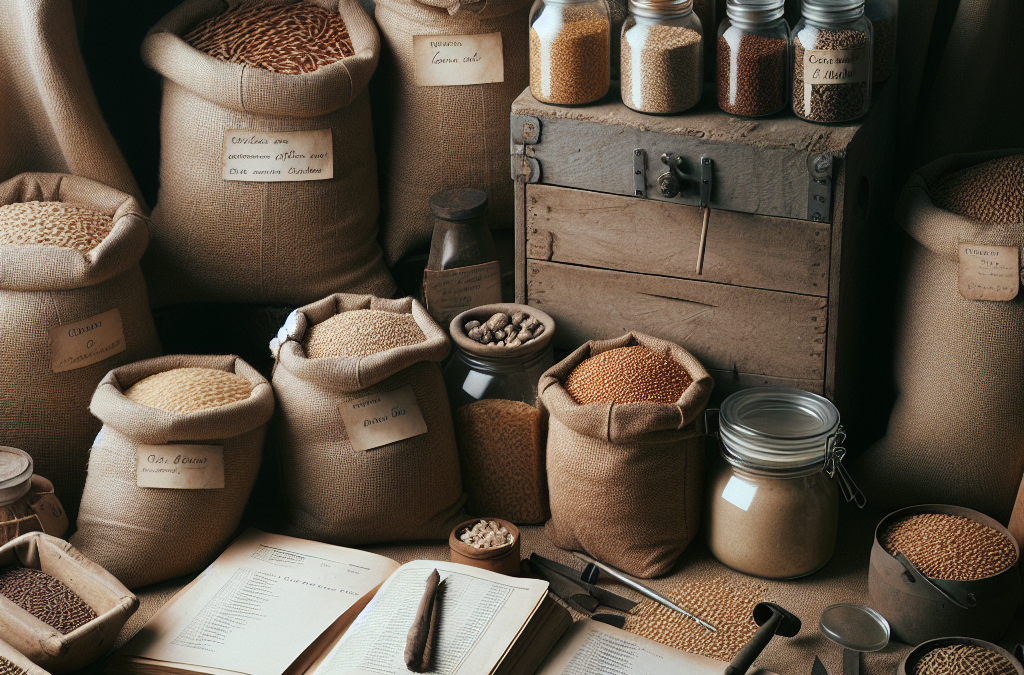Understanding Your Grain Needs
Assessing Quantity and Types of Grains
First things first, let’s talk about what grains you need to store. I started by looking around my kitchen and pantry. Do I use more rice than oats? Is there a type of flour that I whip out on a regular basis? Knowing your habits really helps tailor your storage solution. Take notes on the types of grains you frequently use, and that will help you determine how much space you need.
Next, consider the quantity. It’s tempting to buy in bulk to save a few bucks, but then you have to deal with all that space and potential spoilage. So, make sure to balance your buying habits with actual consumption. I’ve learned the hard way that it’s better to have fewer grains than too many that end up going bad.
Think about all the grains available—rice, wheat, quinoa, oats—be it for baking, cooking, or just snacking. Get clear on your staples. This clarity lets you streamline your storage and prevents any unnecessary clutter.
Recognizing Storage Challenges
Now, you might be wondering where to put all this stuff. Issues like pest control, moisture, and temperature are your enemies if you want to store grain efficiently. When I started my grain storage journey, I had no idea that simply putting grains in a cupboard could invite bugs. After I discovered that, I made it my mission to utilize airtight containers.
Humidity is another foe. Too much moisture can lead to mold or spoilage. I recommend keeping grains in a cool, dry place—like a basement or another well-ventilated area. I also keep an eye on the conditions, especially in humid seasons. A little precaution goes a long way!
Lastly, we need to think about accessibility. Having grains stored all higgledy-piggledy doesn’t help anyone! A system for easy reach and organization will save you time and hassle when you’re cooking or baking.
Setting Up a Minimalist Storage System
Alright, let’s dive into the fun part—getting organized! I’ve found that using clear, labeled containers works wonders. You can see what’s inside without opening each jar. This way, you won’t forget what you have. I also enjoy the aesthetic of matching containers. It just makes the whole space feel nice!
In terms of design, try to group your grains by type or usage. Place the more frequently used grains at eye level. I keep my baking essentials right where they’re easy to grab, while the less commonly used fare is tucked away high up. This can help you save time and keep things streamlined.
Another tip from my own playbook is to rotate your stock. If you follow a first-in, first-out method, this ensures that nothing goes bad before you have a chance to use it. I’ve incorporated this as a regular part of my routine—it takes minimal effort but makes a huge difference.
Choosing the Right Containers
Mason Jars and Airtight Options
When it comes to choosing containers, let me tell you, not all of them are created equal. I find that mason jars are great for visual appeal and sturdiness, but they must be the right size for the grain. I usually reserve large jars for things like flour while using smaller ones for spices and seeds.
Airtight containers are a must for keeping pests out. There’s nothing worse than finding a colony of bugs where you keep your quinoa! Some preferred options also include buckets with gamma lids or vacuum-sealed bags that allow for minimal air exposure.
If you’re feeling fancy, there are even containers that can track moisture levels inside. I’m not that hardcore about it, but it’s cool to know that it’s an option. Whatever you choose, the key is to prioritize functionality over looks. Safe storage is the ultimate goal!
Eco-Friendly Storage Solutions
I’m a firm believer in doing my part for the planet. When I search for grain storage, I aim for eco-friendly materials. Look for containers made from recycled materials or glass. I’ve been slowly transitioning any plastics into sturdy, reusable glass or bamboo options.
Using cloth bags is another great way to store grains, especially in a dry environment. They’re super breathable and can keep the moisture at bay. Plus, they just look charming in a rustic kitchen setting!
Just remember, being eco-friendly doesn’t just mean finding alternatives. It also means making the most out of what you already have. Sometimes, recycling your old jars or containers can do the trick beautifully.
Labeling Your Grains
Labels are your best friend when it comes to organization. I can’t tell you how many times I’ve confused flour for powdered sugar! I’ve started using clear labels to mark each container, and it’s made my life so much easier. Simple, clean labels with the type of grain and date of purchase prevent mix-ups.
Get Whole Wheat Flour, Grains and Milling Supplies – CLICK HERE
You can go old-school with handwritten labels, or you might prefer a label maker for that polished look. I’ve done both, and to be honest, it doesn’t really matter as long as it helps you stay organized.
Additionally, grouping grains in a fun, thematic way (like baking essentials or breakfast grains) can make it easier for you to find what you need, whenever you need it. Take it from me, spending just a little time label-making saves you a ton of stress down the line.
Maintaining Quality Over Time
Regular Checks on Grains
This is probably the most critical part of grain storage. Over time, grains can lose their quality or go stale, so I make it a point to check my stash regularly. I set a reminder every few months to ensure everything is still in tip-top condition. It’s a simple habit that prevents potential waste.
When checking, look for any signs of spoilage such as off smells or unusual textures. I always do a visual inspection before using them. If something seems off, it’s better to toss it than to risk it ruining your meal.
Also, keep a hand on the date you bought them. If you’ve got a batch that’s been there for a while, use them up first. You could have a grain shift from fresh and delightful to stale based on how well you maintain that stock.
Storage Rotation Techniques
A fantastic trick I picked up is to implement a rotation schedule. Basically, when you bring in new stock, make sure to put the old stuff forward. This way, you’re always using the older grains first, maintaining their viability. I promise it really does simplify your storage routine!
It’s super helpful to create a designated space for your new grains, maybe a separate shelf or area. That’s where you’ll place the fresh bags you buy, so you’ll remember which ones need to be consumed soon.
Teaching family or anyone else who might be using the grains about this rotation system can be invaluable too. Everyone will be on the same page, reducing the likelihood of waste.
Understanding Expiration and Shelf Life
Finally, let’s talk shelf life. Most grains have a decent lifespan, but it’s good to know how long each type generally lasts. For example, white rice can last for years, but brown rice has a shorter shelf life because of its oil content. I keep a simple note handy so that I remember the duration!
Be sure to reference storage guidelines. Each grain you have might have its unique rules. Sometimes I’ll be surprised at how long something like quinoa lasts if kept in the right conditions!
Ultimately, it’s crucial to regularly educate myself about the grains I consume. Knowledge is power, and that way, I can make informed decisions while enjoying my home-cooked meals. Plus, sharing this info with friends and family feels great as we work together toward smarter storage!
FAQ
1. What types of containers are best for grain storage?
The best containers for grain storage are airtight jars, buckets with gamma lids, or even vacuum-sealed bags. Each option helps keep pests away and minimizes air exposure to maintain freshness.
2. How can I prevent pests while storing grains?
To prevent pests, always use airtight containers and store your grains in a cool, dry place. Regularly check for any signs of infestation and practice good hygiene in your storage area.
3. Do grains have an expiration date?
Yes, grains do have a shelf life, which varies by type. Most are usable for quite a while, but items like brown rice have a shorter lifespan than white rice due to their natural oil content.
4. How often should I check my stored grains?
I recommend checking your stored grains every three to six months. This helps to ensure they remain fresh and allows you to keep track of what you have.
5. Can I use old grains for cooking?
As long as there are no signs of spoilage, and they smell fine, old grains can certainly be used in cooking. However, always be cautious and err on the side of safety. If in doubt, throw it out!
Get Whole Wheat Flour, Grains and Milling Supplies – CLICK HERE
Related Content
Auto Amazon Links: No products found.





